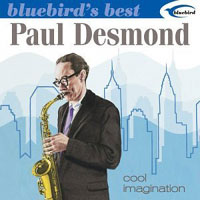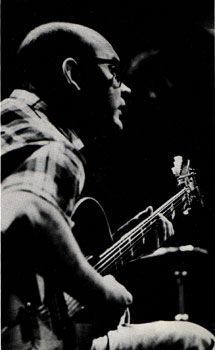

|
Soundclip:
|
| See Steve's Hand-Written Solo
Transcription |
|
Jim Hall's solo on: "Out of Nowhere"(Heyman-Green) At times, a great standard like Johnny Green's "Out of Nowhere" can be overlooked, perhaps because it almost seems to be too simple. But, I believe that it is just this kind of [A] [A2] form tune, with changes that often last for 2 bars, which gives any student of Jazz sufficient time to improvise in a relaxed fashion. And, for the younger players out there, this is perfect for developing a melodic sense while playing. And so, in this spirit, we are presenting a 3-chorus Jim Hall solo from his collection of recordings with Paul Desmond. This particular track was recorded on the June 19th, 1961, but, for reasons which are unclear, was never released until some 26 years later. With the coming of the CD age, and the constant re-packaging of older recordings, tracks like this one tend to reappear in numerous formats. You can presently locate it on Desmond's CD titled, "COOL IMAGINATION"(RCA/Bluebird). For this particular recording session, Desmond, Hall, and drummer Connie Kay were joined by the legendary bassist George Duvivier.  For the sake of doing something a little different, I've decided to treat the analysis portion of Jim Hall's solo on "Out of Nowhere" as it unfolds and develops. This as opposed to the standpoint of looking for the specific improvisational elements. The last note played by Paul Desmond was an F#, and, after allowing a little space(I believe, as courtesy to one's bandmate), Jim begins Chorus 1 and his first note is an F#. Again, if one is relating to the song, solos included, as single entity, a device like this serves as a thread and holds everything together. All skeptics pay attention, because this very device was often employed by the members of the great Miles Davis Quintet as well!!! During [A] of this 1st Chorus, you have some beautiful examples of Hall's slurred, legato phrasing, especially the passage between bars: 11-14. Notice how, in the transition of chords in bars 12-13, the resolution is delayed over the bar-line and the note 'C' could be considered as part of the Am7(3rd) or as the 9th of Bbm7. [A2] of the 1st Chorus is filled with little phrasing gems as well crucial elements to the linear part of the "Jazz Vocabulary." For example, when treating any major chord, the line configuration you see in bar 1 of [A2] is classic, you have a small arpeggio[D-F#-A] in the first half of the bar and that is followed by a line with the following scale degrees: maj7th-Root-3rd-5th. If you study endless solos of the "masters" you will find this configuration constantly. It is essential to know and to call upon it whenever the mood strikes. One also can never overlook the little 'mannerism' on beat 3 of bar 2[a 16th-note triplet and an 8th-note]. Of course, we can find this in countless Charlie Parker solos, but it is also essential to learn how to do this with grace and ease on the guitar. In my view, it is done with one picked stroke and the left-hand does the rest. On beat 3-4 of bar 3, we find another classic linear configuration, but this time it is over a minor chord. Beginning with the 8th-note pick-up, the scale degrees are as follows: 5th-9th-maj7-Root-2nd-m3rd, etc.! During bars 9-12 of this 1/2-chorus, Jim rides an 'E'-natural by playing on both his B-string and his G-string. On the one hand, it is certainly a most guitar-istic thing to do, but it also has some relation to the alternate fingering for saxophonists of the same note. As Chorus 2 begins, one can see and hear the similarity in his phrases as each line, over each chord, ascends and then just as quickly descends. In bar 3 of [A], just to reinforce the idea, on beats 3-4 you see the same linear configuration over Gmaj7: maj7th-Root-3rd-5th. Again, this is something classic that you should know and that should just flow out of you, like speaking comfortably. However, as [A] continues, Jim Hall's preoccupation with thematic development gets him into a bit of trouble.  Perhaps with the little 8th-note triplet pick-up into bar 9, he attempts to take that rhythmic grouping and then run it through the sequence of changes between bars 9-15. As you will hear, it gets a little dicey in a couple of places, making it also tricky to notate. But, that is the nature of improvising. If one is trying to get deep inside the phrasing of this great master, I might focus a bit on the phrase in bar 15 over the Am7 chord. This will give you a great opportunity to use your own legato phrasing, less picking, and you will be forced to include the little 16th-note triplet plus an 8th-note grouping, to which I already alluded. [A2] of this chorus see Hall ascend to his high-register with an 'F' in bar 4, and later, in bar 12 a high 'G' as well. As bars 9-11 are essentially the same during each 1/2-chorus, you might find it interesting to focus on how Jim Hall treats the movement: || Am7 / / / | E7 / / / | Am7 / / / |. In bar 10, over the E7 chord, he simply employs an ascending little arpeggio outlining an E7b9 chord. You can find this configuration in the solos of countless masters too. Perhaps with the little 8th-note triplet pick-up into bar 9, he attempts to take that rhythmic grouping and then run it through the sequence of changes between bars 9-15. As you will hear, it gets a little dicey in a couple of places, making it also tricky to notate. But, that is the nature of improvising. If one is trying to get deep inside the phrasing of this great master, I might focus a bit on the phrase in bar 15 over the Am7 chord. This will give you a great opportunity to use your own legato phrasing, less picking, and you will be forced to include the little 16th-note triplet plus an 8th-note grouping, to which I already alluded. [A2] of this chorus see Hall ascend to his high-register with an 'F' in bar 4, and later, in bar 12 a high 'G' as well. As bars 9-11 are essentially the same during each 1/2-chorus, you might find it interesting to focus on how Jim Hall treats the movement: || Am7 / / / | E7 / / / | Am7 / / / |. In bar 10, over the E7 chord, he simply employs an ascending little arpeggio outlining an E7b9 chord. You can find this configuration in the solos of countless masters too.In his last chorus, Chorus 3, Jim picks-up a small thread of a bluesy-ish line he played in the last bar of the prior chorus, and this reappears in bar 5 of [A]. It is part of a long line of 8th notes which began in the last half of bar 4. Again, during bars 9-12, he employs a sequential idea as the line ascends. Notice the movement in the lower voice: E-F#-G#-A-B-C and finally up to an E-natural. As [A] comes to a close, he finds himself in a descending sequence of what I might describe as 13b9 or 7#9 voicings, depending upon what you consider to be the root. In bar 2 of [A2], a descending arpeggio gets him out of it gracefully. There's a very nice little line in bar 8, which, over an E7(alt.) chord touches upon the following alterations in a very nice configuration: b9 and b5. In essence, a Bb triad is passed over, typical usage of a b5 substitution. A vaguely similar configuration appears again in bar 12, over the F7, but here, the triad is an Ab triad which gives the chord an F7(#9) flavor. In truth, this particular [A2] has a very choppy feel to it, not much flow. But, that's O.K. too because this is risk of improvising. Sometimes, however, it is captured on a recording and one must live with it. Forever!!! As the tune continues, and in their particular tradition of music-making together, Hall and Desmond trade some very melodic 2-bar phrases before the final re-statement of the melody. As we began, I would again advise some the younger players reading these pages to spend some time on this tune, and perhaps tunes like. The reason I am stressing this is that you want to find tunes which give you the opportunity to invent, to be creative and with a relaxed sense of time in which to do that. When the changes last for 2 bars each, as they do during "Out of Nowhere" from bars 1-8 during both [A] and [A2], it is the perfect opportunity to bring out your own best melodic sensibilities. Please give it a try! As always, as tradition dictates, Blaine and I hope that you have enjoyed this year's "Holiday Surprise." We want to thank you all for your visits here, and for your e-mails and Guestbook entries as well. It is always a pleasure to hear from you. And so, from our little corner of cyberspace, we are here to wish everyone a very Merry Christmas and a Happy New Year!!! ¡Felíz Navidad y Felíz Año Nuevo! We are looking forward to beautiful things in 2006!!! Try to do something nice for someone each day!!!
[Photo of Jim Hall by: Sue Singleton]
|